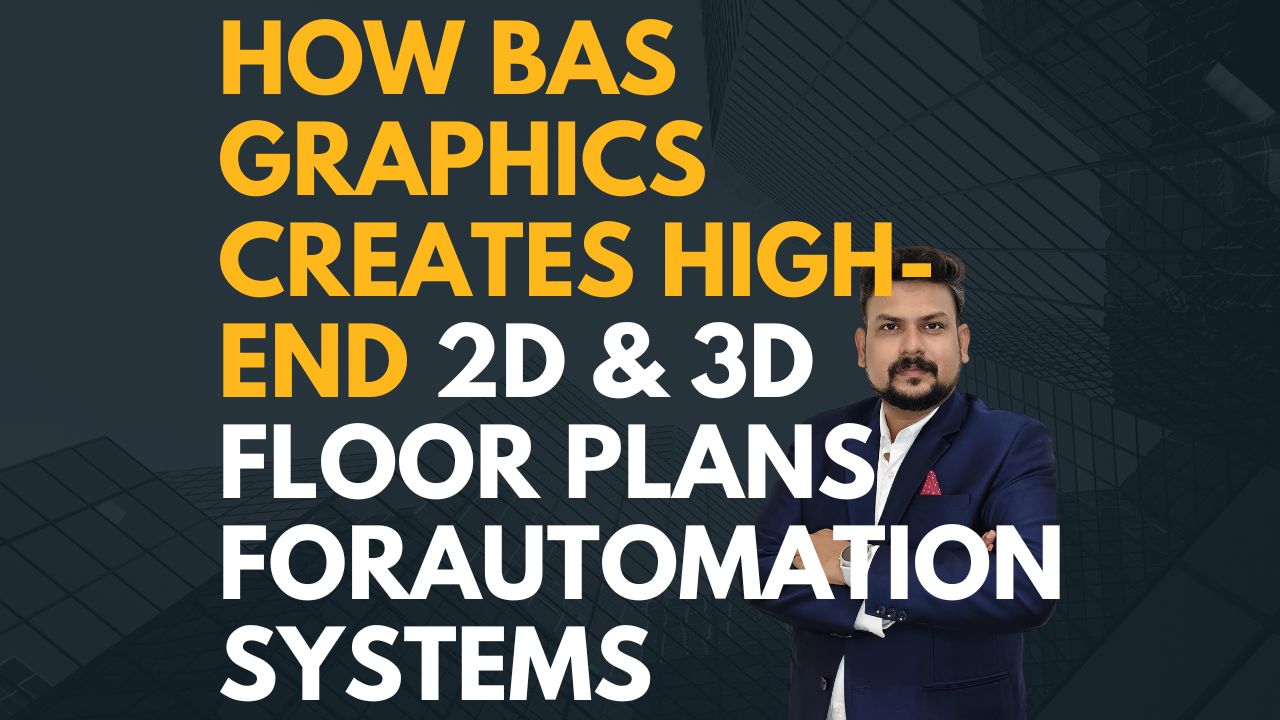How BAS Graphics Creates High-End 2D & 3D Floor Plans for Automation Systems

November 18, 2025
Creating high-quality floor plans for BAS dashboards isn’t just about drawing a building—it’s about integrating real-world equipment, control points, and operational data into a visual interface that operators can use effectively. Here’s how it’s typically done:
- Collecting Accurate Building & System Data
- The process begins with gathering architectural drawings, HVAC layouts, mechanical schematics, and equipment specifications.
- This ensures every duct, pipe, pump, or control device is placed accurately in the plan.
- Field measurements or as-built documentation may also be used for precision.
- Creating a Base 2D Floor Plan
- Using CAD or vector-based tools, a clean 2D floor plan is drawn showing walls, rooms, corridors, and equipment locations.
- Equipment like AHUs, chillers, VAV boxes, pumps, and sensors are represented with standardized symbols.
- Control points are mapped onto these devices so they can be linked later to live data.
- Adding 3D Modeling (Optional but High-End)
- For 3D floor plans, the base 2D layout is converted into 3D models using software like SketchUp, Revit, or specialized BAS 3D tools.
- This allows visualization of mechanical systems in three dimensions, including duct runs, piping, and spatial relationships.
- 3D floor plans can include realistic textures, lighting, and shadows for better comprehension.
- Integrating BAS Components & Live Data
- Symbols for HVAC equipment, valves, sensors, and other devices are linked to the BAS control points.
- This allows the floor plan to show real-time status, such as temperature, flow rates, valve positions, or alarms.
- Dynamic elements like animated fans, pumps, or temperature color changes enhance clarity.
- Ensuring Clarity & Usability
- Floor plans are designed with user experience in mind, so operators can easily navigate and interpret the information.
- Important areas are highlighted, alarms are color-coded, and layouts are simplified to avoid clutter.
- Creating Reusable Templates
- Once a high-end floor plan is created, it can serve as a template for similar buildings or system expansions.
- Standardized symbols, color schemes, and annotations make future projects faster and more consistent.
- Quality Assurance & Testing
- Graphics are reviewed and tested to ensure all interactive elements, live data connections, and animations work properly.
- Feedback from facility managers or operators is incorporated to optimize usability.
Outcome
The result is a professional, high-end 2D or 3D floor plan that:
- Provides a clear overview of building systems
- Integrates live operational data
- Improves troubleshooting, maintenance, and efficiency
- Serves as both an operational and presentation tool
.jpg)
November 20, 2025
.jpg)
November 20, 2025
.jpg)
November 20, 2025
.jpg)
November 20, 2025
.jpg)
November 20, 2025
.jpg)
November 20, 2025
.jpg)
November 20, 2025
.jpg)
November 20, 2025
.jpg)
November 20, 2025
.jpg)
November 20, 2025
.jpg)
November 20, 2025
.jpg)
November 20, 2025

November 20, 2025

November 19, 2025



November 19, 2025

November 19, 2025

November 19, 2025

November 19, 2025

November 18, 2025

November 18, 2025





November 18, 2025

November 18, 2025


November 17, 2025


.jpg)
November 17, 2025
.jpg)
November 17, 2025
.jpg)
November 17, 2025
.jpg)
November 17, 2025
.jpg)
November 17, 2025
.jpg)
November 15, 2025
.jpg)
November 15, 2025
.jpg)
November 15, 2025
.jpg)
November 15, 2025
.jpg)
November 15, 2025
.jpg)
November 15, 2025
.jpg)
November 15, 2025
.jpg)
November 15, 2025
.jpg)
November 15, 2025
.jpg)
November 15, 2025
.jpg)
November 15, 2025
.jpg)
November 15, 2025
.jpg)
November 15, 2025
.jpg)
November 15, 2025
.jpg)
November 15, 2025
.jpg)
November 15, 2025
.jpg)
November 15, 2025
.jpg)
November 15, 2025
.jpg)
November 15, 2025
.jpg)
November 15, 2025
.jpg)
November 15, 2025
.jpg)
November 15, 2025
.jpg)
November 15, 2025
.jpg)
.jpg)
.jpg)
November 8, 2025
.jpg)
November 5, 2025
.jpg)
November 4, 2025
.jpg)
.jpg)
November 2, 2025
.jpg)
November 1, 2025
.jpg)
October 31, 2025
.jpg)
October 30, 2025
.jpg)
October 28, 2025
.jpg)
October 28, 2025
.jpg)
.jpg)
October 28, 2025
.jpg)
October 25, 2025
.jpg)
October 24, 2025
.jpg)
October 23, 2025
.jpg)
.jpg)
October 17, 2025
.jpg)
October 16, 2025
.jpg)
October 15, 2025
.jpg)
October 16, 2025
.jpg)
October 10, 2025
.jpg)
October 6, 2025
.jpg)
September 29, 2025
.jpg)
September 26, 2025
.jpg)
September 23, 2025
.png)
.jpg)
September 3, 2025

September 2, 2025
.jpg)
September 1, 2025
.jpg)
September 1, 2025
.jpg)
September 1, 2025
.png)
.png)
September 1, 2025

September 1, 2025
.png)
September 1, 2025
.png)
.png)
September 1, 2025
.png)
September 1, 2025

September 1, 2025
.png)
September 1, 2025

September 1, 2025

September 1, 2025

September 1, 2025

September 1, 2025
.png)
September 1, 2025

September 1, 2025
.png)
September 1, 2025
.jpg)
September 1, 2025
.jpg)
September 1, 2025
.jpg)
September 1, 2025
.jpg)
September 1, 2025

September 1, 2025
.jpg)

September 1, 2025

September 20, 2024

September 13, 2024

September 5, 2024

August 31, 2024

August 28, 2024



May 14, 2024
.jpg)










.jpg)
.jpg)
.jpg)
.jpg)
.jpg)
.png)

.jpg)


